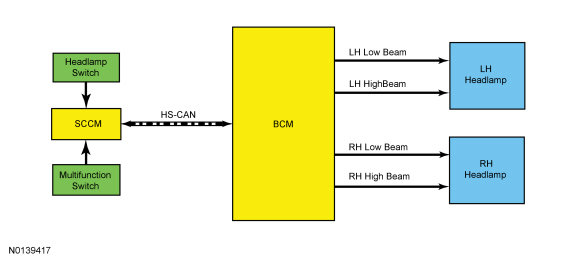SECTION 417-01: Exterior Lighting
| 2014 Flex Workshop Manual
|
DESCRIPTION AND OPERATION
| Procedure revision date: 05/02/2013
|
Overview
The headlamp system consists of:
The headlamp system is a dual-beam pattern system. It consists of a single replaceable headlamp bulb in each headlamp assembly. The vehicle may come equipped with halogen or HID bulbs. The park/turn and side marker lamps are integrated into the headlamp assembly.
System Operation

Network Message Chart
BCM Network Input Messages
| Broadcast Message | Originating Module | Message Purpose |
|---|---|---|
| Headlamp switch status | SCCM | Indicates the headlamp switch position (or fault) to the BCM . When the position is indicated as the headlamps on (or a fault), the BCM provides voltage to the parking lamps and headlamps. |
| Flash-to-pass request | SCCM | Indicates to the BCM a request for the high beams or flash-to-pass. |
Battery Saver
NOTE: The battery saver time-out is 1 minute if the vehicle has less than 201 km (125 mi).
NOTE: The battery saver does not control the parking lamps if the headlamp switch is in the parking lamps on position.
To save battery voltage, the BCM provides automatic shut-off of the interior and exterior lamps after a time-out period when the ignition is off. The BCM monitors the ignition state and input from the RKE system to determine when to energize or de-energize the battery saver relay and to shut the power off to the lamps. A timer in the BCM starts when:
When 10 minutes have elapsed, the BCM automatically shuts off voltage to the lamps. The timer restarts (voltage is restored if the BCM is in battery saver mode) if:
Low Beams
The SCCM monitors the headlamp switch position and sends a headlamp switch status message over the HS-CAN to the BCM to indicate the headlamp switch status (position or a fault with the headlamp switch).
The BCM turns the parking lamps and headlamps on if it loses communication with the SCCM , or if the SCCM detects a fault from the headlamp switch. The head lights will remain on until the battery saver feature times out (refer to Battery Saver in this section).
When the BCM receives a message requesting the headlamps on, it supplies voltage to the headlamp bulbs (halogen headlamps) or the ballasts ( HID headlamps) within each headlamp assembly.
Vehicles with halogen headlamps use dual filament bulbs.
Vehicles with HID headlamps utilize a ballast, mounted to each headlamp assembly, to provide the necessary voltage to illuminate the HID bulbs.
The BCM also provides an overload protection of the low beam output circuits. When an excessive current draw is detected, the BCM disables the affected low beam circuit driver. Refer to FET in Section 419-10 .
High Beams
The SCCM monitors the multifunction switch for a high beam or flash-to-pass request. When the multifunction switch is in the high beam or flash-to-pass position, the SCCM sends a high beam flash-to-pass request message to the BCM over the HS-CAN indicating the request.
Vehicles with halogen headlamps, when the high beams are requested, the high beams are illuminated and the low beams turn off.
Vehicles with HID headlamps, when the low beams are on and the BCM receives a request for high beams, the headlamps remain powered and the shutter within each headlamp is activated. This changes the headlamp beam pattern to illuminate a greater distance.
The BCM also provides an overload protection of the high beam output circuits. When an excessive current draw is detected, the BCM disables the affected high beam circuit driver. Refer to FET in Section 419-10 .
Flash-To-Pass
The SCCM monitors the multifunction switch for a high beam or flash-to-pass request. When the multifunction switch is in the high beam or flash-to-pass position, the SCCM sends a high beam flash-to-pass request message to the BCM over the communication network indicating the request.
When the low beams are off and the flash-to-pass is requested, the headlamp bulbs and the shutters are activated for approximately 0.5 second. When the low beams are on and the flash-to-pass is requested, the shutters within the headlamps are activated as long as the multifunction switch is held in the flash-to-pass position.
Component Description
Headlamp Assembly — HID Headlamps
The headlamp assembly has an integrated solenoid activated shutter which changes the headlamp beam pattern when activated. The solenoid and shutter are not serviceable separately from the headlamp assembly. The headlamp assembly is provided power on independent circuits for the low beams and the high beams.
Exterior lamps are vented to accommodate normal changes in pressure. Condensation can be a natural by-product of this design. When moist air enters the lamp assembly through the vents, there is a possibility that condensation can occur if the temperature is cold. When normal condensation occurs, a thin film of mist can form on the interior of the lens. The thin mist eventually clears and exits through the vents during normal operation. Time to clear the lens of acceptable mist varies with ambient humidity and lamp types. Normal condensation clears from any lamp in 48 hours under dry conditions.
Do not replace a lamp assembly with acceptable levels of condensation such as:
Examples of unacceptable moisture (usually caused by a lamp housing leak):
Ballast
On vehicles equipped with HID headlamps, there is a ballast located within each headlamp assembly. They are provided power at all times from the BJB . The ballasts provide high voltage to the HID bulbs when voltage from the BCM (low beam outputs) is detected.